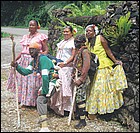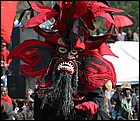
Festival of Diablos and Congos





Festival of Diablos and Congos
The most unique and colorful manifestation folklore of the provice of Colon. The tradition of the dances and the interpretation of the Afro-American culture are expressed with an impressive visual wealth in the Festival of dances of Devils and Congos of Colon. These dances have great historic value in the Afro-Panamanian culture.
The dance has very old African roots, is full of strong dance routines, rhythmic drum beats and music, colors, elaborate, colorful and often outrageous costumes, lavish masks, chants, magic, myth, and songs. It has been passed on from generation to generation, conserved to the present time in the province of Colon, where the Afro-Panamanian legacy stays alive as part of its identity.
The Congos of Portobelo today are the descendants of the cimarrones—runaway slaves who fiercely fought for their freedom during the Spanish colonial period. After escaping into the hills and rainforests, the cimarrones built fortified villages known as palenques from which they waged wars against their former enslavers. So successful were they in war, that the Spaniards were forced to recognize their freedom. Today, the Congos memorialize their ancestors during Congo Carnival in street performances, music, dance, and costumes.
It is a dance spectacle full of enchantment and spell that evokes fear and curiosity, in which men and women stage with dances, songs and sonorous drums, the ancestral drama of life, and the fight between the good and evil.
The diablos, chosen by each community, are wonderfully costumed with elaborate outfits and masks. They "play" during carnaval. The plot of the congo dance is that the characters represent the congos and fight the devil who is said to be loose or unleashed during the carnival. At the end they are saved by the “Reina Conga”, queen of the congos, helped by the “Pajarito”, little bird, and “Juan Dios”, John God. This traditional dance exhibits fusion between the catholic religion and the Afro-Antillean cultures.
These dances are can also be seen during the Carnaval period and the local fair: "Feria de Colon"

